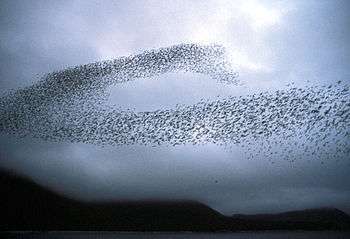Active matter
Active matter is composed of large numbers of active "agents", each of which consumes energy in order to move or to exert mechanical forces.[1][2] Due to the energy consumption, these systems are intrinsically out of thermal equilibrium. Examples of active matter are schools of fish, flocks of birds, bacteria, artificial self-propelled particles, and self-organising bio-polymers such as microtubules and actin, both of which are part of the cytoskeleton of living cells. Most examples of active matter are biological in origin; however, a great deal of current experimental work is devoted to synthetic systems. Active matter is a relatively new field in soft matter physics: the most extensively studied model, the Vicsek model, dates from 1995.[3]
Research in active matter combines analytical techniques, numerical simulations and experiments. Notable analytical approaches include hydrodynamics,[4] kinetic theory, and non-equilibrium statistical physics. Numerical studies mainly involve self-propelled-particles models,[5][6] making use of agent-based techniques and molecular dynamics algorithms. Experiments on biological systems extend over a wide range of scales, including animal groups (e.g., bird flocks,[7] mammalian herds, fish schools and insect swarms[8]), bacterial colonies, cellular tissues (e.g. epithelial tissue layers,[9] cancer growth and embryogenesis), cytoskeleton components (e.g., in vitro motility assays, actin-myosin networks and molecular-motor driven filaments[10]). Experiments on synthetic systems include self-propelled colloids (e.g., phoretically propelled particles[11]), driven granular matter (e.g. vibrated monolayers[12]), swarming robots and Quinke rotators.
Concepts in Active matter
- Active gels
- Dense active matter
- Collective motion
- Motility induced phase separation
- Schooling, flocking and swarming
Active matter systems
- Biological tissues
- Subcellular and cell mechanics
- Crowd behaviour
- Self-propelled particles and colloids
References
- ↑ Ramaswamy, Sriram (2010-01-01). "The Mechanics and Statistics of Active Matter". Annual Review of Condensed Matter Physics. 1 (1): 323–345. arXiv:1004.1933
 . Bibcode:2010ARCMP...1..323R. doi:10.1146/annurev-conmatphys-070909-104101.
. Bibcode:2010ARCMP...1..323R. doi:10.1146/annurev-conmatphys-070909-104101. - ↑ Marcetti, M. C.; Joanny, J.F.; Ramaswamy, S.; Liverpool, T. B.; Prost, J.; Rao, M.; Adita Simha, R. (2012). "Hydrodynamics of soft active matter". Reviews of Modern Physics. 85: 1143–1189. arXiv:1207.2929
 . Bibcode:2013RvMP...85.1143M. doi:10.1103/RevModPhys.85.1143.
. Bibcode:2013RvMP...85.1143M. doi:10.1103/RevModPhys.85.1143. - ↑ Vicsek, T.; Czirok, A.; Ben-Jacob, E.; Cohen, I.; Shochet, O. (1995). "Novel type of phase transition in a system of self-driven particles". Physical Review Letters. 75 (6): 1226–1229. arXiv:cond-mat/0611743
 . Bibcode:1995PhRvL..75.1226V. doi:10.1103/PhysRevLett.75.1226. PMID 10060237.
. Bibcode:1995PhRvL..75.1226V. doi:10.1103/PhysRevLett.75.1226. PMID 10060237. - ↑ Toner, John; Tu, Yuhai; Ramaswamy, Sriram (2005-07-01). "Hydrodynamics and phases of flocks". Annals of Physics. Special Issue. 318 (1): 170–244. Bibcode:2005AnPhy.318..170T. doi:10.1016/j.aop.2005.04.011.
- ↑ Vicsek, Tamás; Czirók, András; Ben-Jacob, Eshel; Cohen, Inon; Shochet, Ofer (1995-08-07). "Novel Type of Phase Transition in a System of Self-Driven Particles". Physical Review Letters. 75 (6): 1226–1229. arXiv:cond-mat/0611743
 . Bibcode:1995PhRvL..75.1226V. doi:10.1103/PhysRevLett.75.1226. PMID 10060237.
. Bibcode:1995PhRvL..75.1226V. doi:10.1103/PhysRevLett.75.1226. PMID 10060237. - ↑ Chaté, Hugues; Ginelli, Francesco; Grégoire, Guillaume; Raynaud, Franck (2008-04-18). "Collective motion of self-propelled particles interacting without cohesion". Physical Review E. 77 (4): 046113. arXiv:0712.2062
 . Bibcode:2008PhRvE..77d6113C. doi:10.1103/PhysRevE.77.046113.
. Bibcode:2008PhRvE..77d6113C. doi:10.1103/PhysRevE.77.046113. - ↑ Ballerini, M.; Cabibbo, N.; Candelier, R.; Cavagna, A.; Cisbani, E.; Giardina, I.; Lecomte, V.; Orlandi, A.; Parisi, G. (2008-01-29). "Interaction ruling animal collective behavior depends on topological rather than metric distance: Evidence from a field study". Proceedings of the National Academy of Sciences. 105 (4): 1232–1237. arXiv:0709.1916
 . Bibcode:2008PNAS..105.1232B. doi:10.1073/pnas.0711437105. ISSN 0027-8424. PMC 2234121
. Bibcode:2008PNAS..105.1232B. doi:10.1073/pnas.0711437105. ISSN 0027-8424. PMC 2234121 . PMID 18227508.
. PMID 18227508. - ↑ Buhl, J.; Sumpter, D. J. T.; Couzin, I. D.; Hale, J. J.; Despland, E.; Miller, E. R.; Simpson, S. J. (2006-06-02). "From Disorder to Order in Marching Locusts". Science. 312 (5778): 1402–1406. Bibcode:2006Sci...312.1402B. doi:10.1126/science.1125142. ISSN 0036-8075. PMID 16741126.
- ↑ Trepat, Xavier; Wasserman, Michael R.; Angelini, Thomas E.; Millet, Emil; Weitz, David A.; Butler, James P.; Fredberg, Jeffrey J. (2009-06-01). "Physical forces during collective cell migration". Nature Physics. 5 (6): 426–430. Bibcode:2009NatPh...5..426T. doi:10.1038/nphys1269. ISSN 1745-2473.
- ↑ Keber, Felix C.; Loiseau, Etienne; Sanchez, Tim; DeCamp, Stephen J.; Giomi, Luca; Bowick, Mark J.; Marchetti, M. Cristina; Dogic, Zvonimir; Bausch, Andreas R. (2014-09-05). "Topology and dynamics of active nematic vesicles". Science. 345 (6201): 1135–1139. arXiv:1409.1836
 . Bibcode:2014Sci...345.1135K. doi:10.1126/science.1254784. ISSN 0036-8075. PMC 4401068
. Bibcode:2014Sci...345.1135K. doi:10.1126/science.1254784. ISSN 0036-8075. PMC 4401068 . PMID 25190790.
. PMID 25190790. - ↑ Palacci, Jeremie; Sacanna, Stefano; Steinberg, Asher Preska; Pine, David J.; Chaikin, Paul M. (2013-02-22). "Living Crystals of Light-Activated Colloidal Surfers". Science. 339 (6122): 936–940. Bibcode:2013Sci...339..936P. doi:10.1126/science.1230020. ISSN 0036-8075. PMID 23371555.
- ↑ Deseigne, Julien; Dauchot, Olivier; Chaté, Hugues (2010-08-23). "Collective Motion of Vibrated Polar Disks". Physical Review Letters. 105 (9): 098001. arXiv:1004.1499
 . Bibcode:2010PhRvL.105i8001D. doi:10.1103/PhysRevLett.105.098001.
. Bibcode:2010PhRvL.105i8001D. doi:10.1103/PhysRevLett.105.098001.

